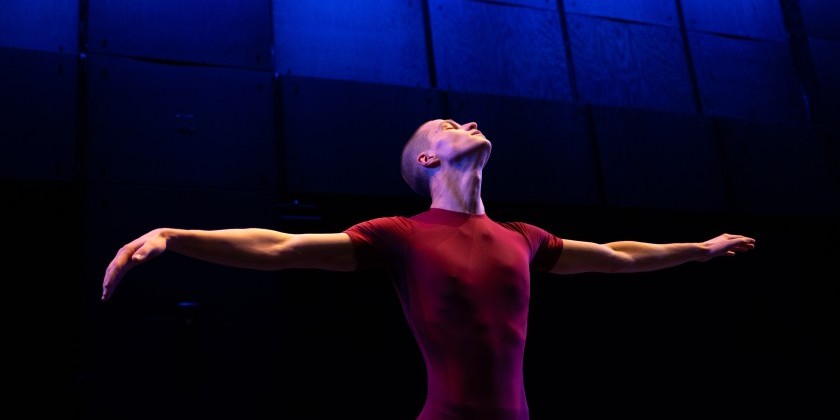IMPRESSIONS: John Scott Dance & Mel Mercier's "Begin Anywhere" at the Irish Arts Center

John Scott Dance and Mel Mercier
Begin Anywhere
Commissioned by Irish Arts Center
Five Solos by Merce Cunningham
By arrangement with the Merce Cunningham Trust
The JL Greene Theatre at Irish Arts Center
Artists and Program Notes: Click here
February 12-16, 2025
The great choreographer, Merce Cunningham, a major influence on decades of dance makers, died in 2009, at which time the Merce Cunningham Dance Company no longer performed. Since then, Cunningham’s dances are rarely seen, especially in the U.S., but for over the past fifteen years Irish choreographer and operatic tenor, John Scott has brought several revivals including Night Wandering and Totem Ancestor to our shores.
This time, five Cunningham solos from 1957-1968, Changeling, Solo, two from Antic Meet and RainForest, were convincingly presented in the first part of a two-part program at the Irish Arts Center, February 12-16, 2025. These much-welcomed solos set the stage for the premiere of Scott’s and Irish composer Mel Mercier’s, Begin Anywhere, a tribute to both Cunningham and Cunningham’s partner, composer John Cage. Cunningham and Cage’s controversial work changed the direction of 20th century performing arts.

The big and boisterous dance, 33-minutes and 10 years in the making, and arguably Scott’s highest dance achievement, may take physical cues from Cunningham and musical cues from Cage, but it is entirely its own marvellous entity. The movement eats and fills the space engaging Mercier’s traditional Irish music and electronic score. Mercier, a musician with the Cunningham company in the 1980s, most notably performed in Cage’s Roaratorio, an Irish Circus on Finnegans Wake for Cunningham’s dance, Roaratorio. Roaratorio features a series of duets to Irish jigs and reels and James Joyce’s transposed lines. Taking a cue, Begin Anywhere includes Irish music, duets and talk.

The sublime dancers, one woman and four men, costumed in pedestrian pants and shirts, hail from four countries and speak, at one point, in their (untranslated) native languages. There are also hard to decipher layered recorded comments by former noteworthy members of the Merce Cunningham Dance Company. Mostly a distraction, the comments, “I always struggled with that,” says one, allude to the transmission of legacy. Presumably, this inclusion satisfied an Irish/American grant application, as discussed during post show acknowledgements.
Dancer Magdelana Hylak steps into the white lit horizontally narrow theater carrying a cassette player on which plays a nondistinctive scratchy sound. She gyrates behind the cassette player that rests on the stage while white-bearded musician Mick O’Shea enters and sits in back of his instrument creation (what looks to be the inside of an amplifier, with wires and colored knobs woven together on two metal bases.) While the electronic instrument produces a low humming undertone, a bow strummed across a wire yields a nuanced and delicate sound. Ryan O’Neill, a longtime member of Scott’s award-winning Irish Modern Dance Theatre, now called John Scott Dance, joins Hylak. They lunge wide-legged, a Cunningham trait, and slice a hand, palm down, elbow bent, across their chests, a thematic movement seen throughout the dance. Vinícius Martins Araújo jigs along the front of the stage and is soon joined by Boris Charrion and the impressively sleek François Malbranque.

One by one the musicians take their places on three sides of the dancing space. Mercier and violinist Claudia Schwab, playing Irish jigs and reels, perch behind the dancers while Kevin McNally, who plays strings, stands stage right. The four stationery musicians, including O’Shea stage left, are a watchful presence as the choreography subtly interacts with the music. The eloquent Mercier shakes the rhythm bones, and later beats the bodhrán, a traditional Irish drum, with practiced aplomb.

Full out runs, leaps and wild spins return again and again. While moving as a herd the dancers express a kinship and companionability. Two or three strike out on their own and like young bucks and hind, they find their own joyous movement that evokes the open landscapes of fields and skies. They push, pull and careen, whiplashing the blissfully engaged viewer. Cunningham’s Pictures is referenced in a line of unhurried, unattached then reconnected dancers. In one section the dancers count each of 100 movements (in cadences of 11) that snake back and forth across the stage. A wacked-out shivery movement, anxiously danced in place, edges into the psychological realm and acts as a coda to the phrases. Toward the end, lifting and carrying partnering duets reference Roaratorio. A low delighted growl from the dancers and breath through a tube by a musician accompanies the final satisfying moments.












